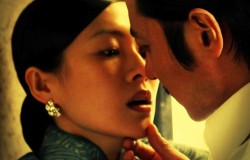Stefano Odorico reviews Hur Jin-Ho’s Dangerous Liaisons, which comes to The Hyde Park Picture House as part of the Pan-Asia Film Festival
The Pan-Asia Film Festival returns to Leeds with a UK première: Dangerous Liaisons, by Hur Jin-ho (2012), an oriental remake of the famous French novel.
Dangerous Liaisons is cinema and the theatre is its natural environment. Its artistic value is best appreciated, I believe, when viewed on a big screen in a small picture house such as the Hyde Park Picture House.
In brief, Pierre Choderlos de Laclos’ famous story emigrates to a romantic and melodramatic Shanghai of the 1930’s, a setting which works almost as well as the original. I enjoyed watching it, and even did so for a second time. It is clear from early on that no expense was spared in the making of this production but ultimately what it gives to us is nothing more than an expensive and well executed (western) costume drama. It never gets boring but, at the same time, it fails to ever get truly exciting.
Furthermore, and this might be disappointing for the aficionados of oriental pictures, Dangerous Liaisons comes across as a non-asian film; meaning that, despite the impressive cast of asian stars performing and the locations used, this artifact somehow appears very western due to the nature of the story itself and the numerous Paris-esque locations.
As many already know, Choderlos’ fine narrative work has been transposed to the big screen several times over the years, obtaining different results, including: the ‘great’ (“Dangerous Liaisons”, 1988 by Stephen Frears); the ‘different’ (“Untold Scandal”, 2003 by Lee Je-Long, Korean version of the story); the ‘sad’ (“Valmont”, 1989 by Milos Forman); and the relatively ‘unknown’ (“Les Liaisons dangereuses”, 1959 by Roger Vadim, which transposes the story to the 1950′s and set it amongst the French bourgeois environment); the ‘popular’ (and personally disturbing “Cruel Intentions”, 1999 by Roger Kumble set in contemporary New York). Most recently, Dangerous Liaisons (2012), presented at Cannes in the “Directors’ Fortnight” category, places itself in between the ‘great’ and the ‘different’. It adheres almost completely, apart from some changes to the ending, to the original famous French story, which is why I will not summarise it in this review.
With the intent of making a sort of parallel between France prior to the revolution (the book is from 1782) and China before the Japanese occupation, Yan Geling sets the story in 1931 Shanghai: a very nationalistic city that has not yet been affected by the Maoist revolution. Shanghai in this particular historical period was at his best, in fact it was also known as the ‘Paris of the Orient’ because of all its cultural, architectonic and social affinities with the French capital. As testified by the film itself it was an amazing place to live up until the famous battle of Shanghai in 1937 during the Second Sino-Japanese War (only a few years later). Through the use of a lot of stunning CGI, the film glitters with expensive cars, elegant clothes, astonishing set pieces, art nouveau interiors (many Tiffany lamps) and luxurious buildings. However, I found the photography too bright, too shiny and often disturbing and not, it seems, for any good reason. A good example of this is the balcony scene which captures, with surreal colours and light, a conversation between Xie Yifan and Mo Jieyu before the camera moves over Shanghai to linger on the numerous boats on the Yangtze river.
In the opulent buildings live the big stars of the film: the playboy Xie Yifan – The Vicomte de Valmont – with his handsome face and perfect haircut; the femme fatale brilliantly interpreted by Mo Jieyu – Marques Merteuil – (characters that both continuously play games of power that will ultimately get the better of them); and, of course, the omnipresent Chinese diva and dagger thrower Zhang Ziyi, who plays the part of the virtuous (and naive) young widow Du Fenyu – Madame de Tourvel.
The context is a life of luxury; a bourgeois China of the 1930’s characterised by political battles and class conflicts, both elements that are particularly important in this film. Notably, when the original character of Cécile, renamed Beibei in this oriental remake, falls in love with the proletarian painter Wenzhou the film strongly underlines how love had little part to play in weddings at the time.
Furthermore, the Opera sequence (probably one of the best of the entire film) represents one of the few moments in which politics powerfully enters the narrative. However, even though it is clearly the political component of this scene, the director continues to use his personal style dominated by soft and smooth close ups. Which means that ultimately, even if in this case the focus is on a real social and political event, the leitmotif of the whole work is still sensuality.
To conclude, this remake of Dangerous Liaisons is a film created for the theatre and, if I have to define it in a single sentence: it is the representation of dualism between love and passion as an affirmation of our individual freedom against pre-constituted (and archaic) moral rules. In addition to being, in general, a creation of Asian aesthetics trapped in a western editing.
Enjoy it.
Dangerous Liaisons is showing at the Hyde Park Picture House on 4 March at 6pm, to book your ticket visit www.hydeparkpicturehouse.co.uk
To find out more about the Pan-Asia Film Festival visit: www.asiahouse.org/arts-and-culture/pan-asia-film-festival
